Dirtside Challengers
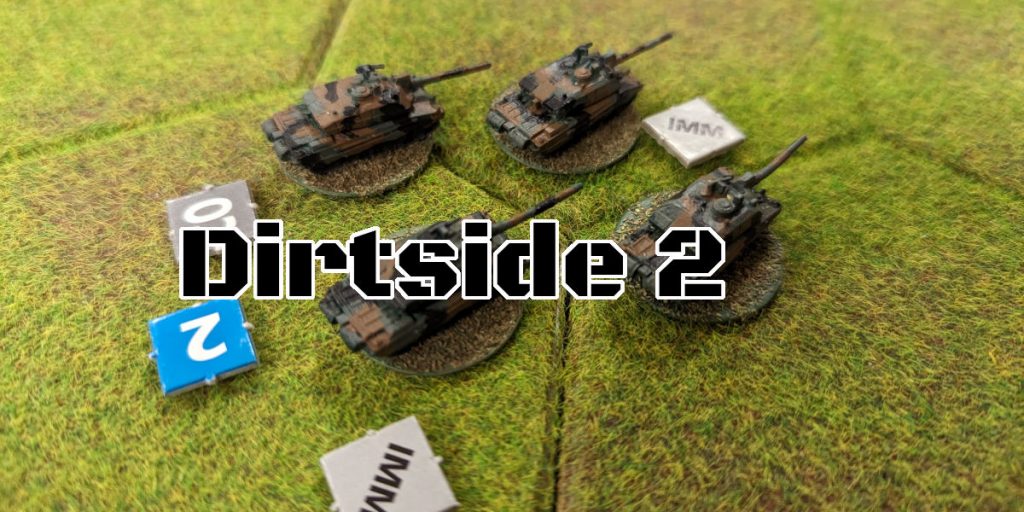
One of the things that I’ve been working on recently is making some conversations for Dirtside II. Dirtside is designed for 6mm SciFi wargaming, but I’m extending it for modern combat. This means coming up with designs for modern day tanks and other fighting vehicles.
This week, it was time to give some of the conversions a go, by having a simple head to head tank battle between Russian and NATO forces. Each unit consisted of 4 vehicles, and to keep things simple there was no supporting infantry.
On the NATO side there were:
- 1x unit of Challenger 2 tanks
- 2x units of Leopard 2 tanks
On the Russian side:
- 1x unit of T-90 tanks
- 3x units of T-80 tanks
- 2x units of T-72 tanks
The NATO forces were outnumbered 2 to 1, but my guess was that they should be able to hold their own. My feeling is that the NATO designs may be overpowered compared to the Russian designs, and I wanted to see what the results would be for an asymmetric battle.
The terrain was relatively open rolling hills (courtesy of Kallistra hex terrain) with some light woods for cover. Vehicles could up and down one level without issue, but two levels were considered cliffs which can’t be traversed.

To reduce the number of variables, we gave each unit a quality rating of 2 regular. I don’t yet have accurate point values for these vehicles – they are using some non-standard weapons and armour types, so my idea at the moment is to not bother using a fine grained point system.
The Russians started, opening up with a salvo of guided missiles from their T-80s to a unit of Leopards. At that point I noticed that the Leopards and Challengers had listed LAD (Local Air Defence) systems down, when they should probably have PDS. The GMS/H system on the T-80 represents the ATGMs that Russian tanks can fire from their 120mm gun barrels.
As standard, Dirtside doesn’t really differentiate between AT and AA missiles – a guided missile can hit anything. I’ve split the two, specifying whether a GMS is Anti-Tank or Anti-Air.
The first couple of turns of combat (it turned out I was really bad at keeping detailed notes) resulted in some mobility hits and damage against the NATO tanks, but no actual casualties. Meanwhile, the Russian tanks started taking some losses.

Some T-72s tried to cross the valley, and the Challengers opened up with opportunity fire, destroying one and immobilising a second. I’d forgotten to use the T-72’s side armour in this instance, but I don’t think it made a difference.
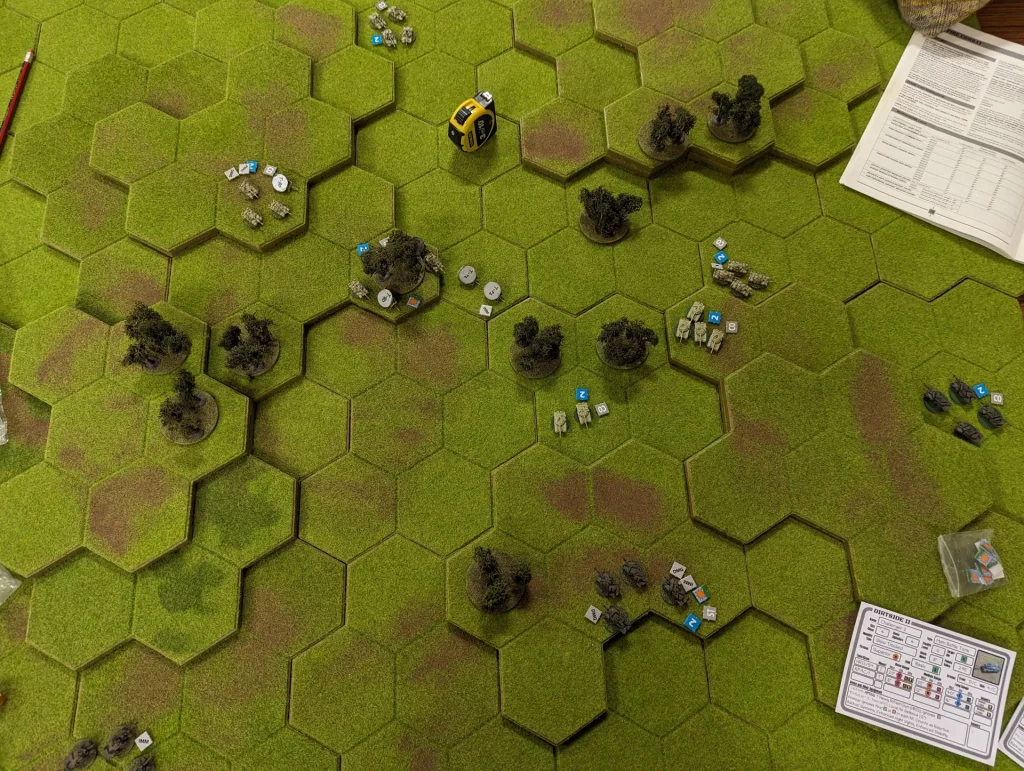
On Turn 3, Russia got their first kill against a NATO tank – taking out a Leopard 2 with a GMS round. By this point, two of the Challengers had also been immobilised. They were still more than capable of returning fire, but they were preventing the unit from manoeuvring. So the two damaged tanks were abandoned and the other half of the unit started to move around the flank.
The central Leopard unit ended up taking the brunt of the damage. The second Leopard unit moves around the flank to the East to try and flush out the Russian tanks sheltering in woods and behind hills, whilst the two remaining Challengers to the same to the West. The second Leopard unit hadn’t been doing much until this point, which meant NATO firepower has been about two thirds of what it could have been.
Eventually, two of the central Leopards are taken out, and with the other half of the unit immobilised, the crew bail out and retreat.
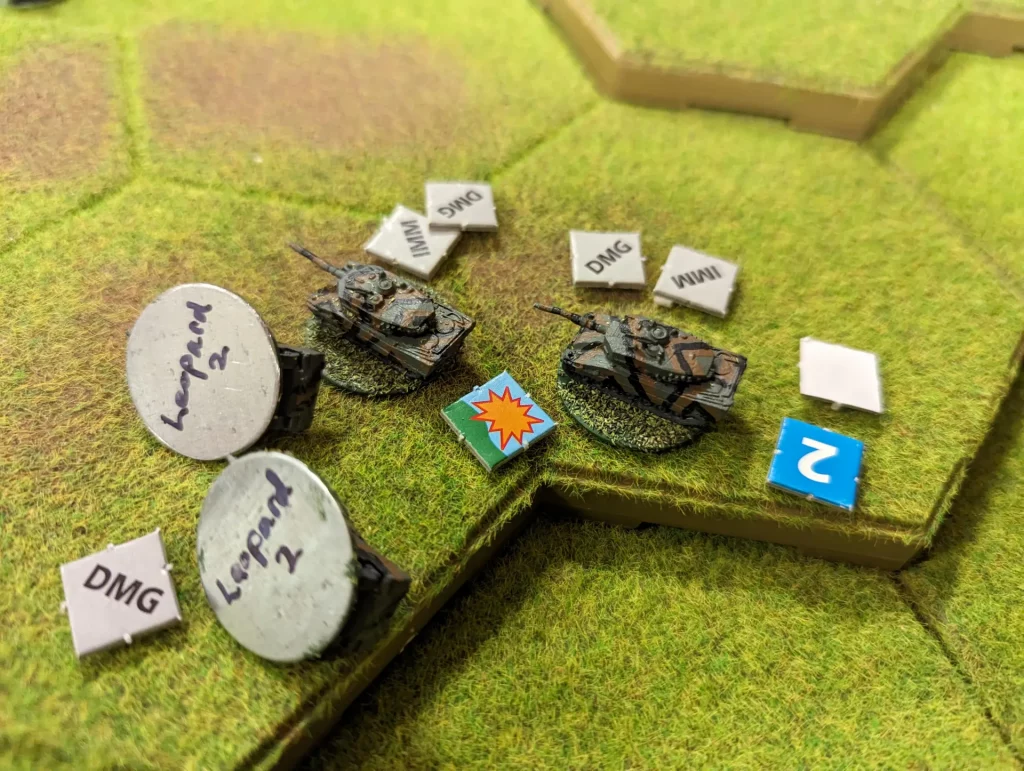
On the Eastern flank, the Leopards run into a unit of T-80s at point blank range. One of each is destroyed, after some bad rolls on the part of NATO. But then, this is balanced by some bad rolls that Russia had been making all through the game.
At this point, NATO decides that it’s probably had enough. Most of its casualties have been non-fatal, with a lot of mobility hits and some damaged tanks.
Russia has taken more losses, but not considerably more. There were more actual kills by NATO than there were by Russia. Only three NATO tanks were actually killed, the other losses were due to being immobilised and abandoned.
The main weapon used by Russia were their guided missiles. The NATO forces had no missiles of their own, and no area defence either, the latter of which would probably have forced a change in Russian tactics. The lack of ammo tracking meant that the Russians could use as many missiles as they wanted, which probably wasn’t realistic, but keeps things simple.
I think the T-72’s gun may need upgrading to being similar to the T-80 and T-90, which would make it a bit more useful. Like NATO, the LAD systems should possibly be PDS instead. I do need to revisit the differences between these tanks. Since this is geared towards modern engagements, I do need to consider that things like the T-72 have been upgraded a lot over the years, so it should be a 1970s era T-72, but a 2020 era T-72.


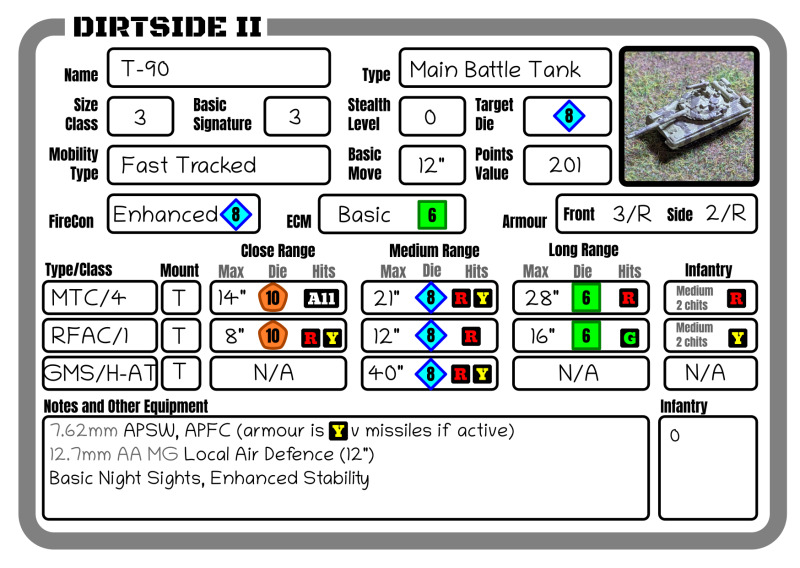
The NATO tanks are probably around where I want them to be. I think they should be better than the Russian tanks (mostly due to their armour, and ability to not have their auto loaders explode when the tank is hit), how much is the question.

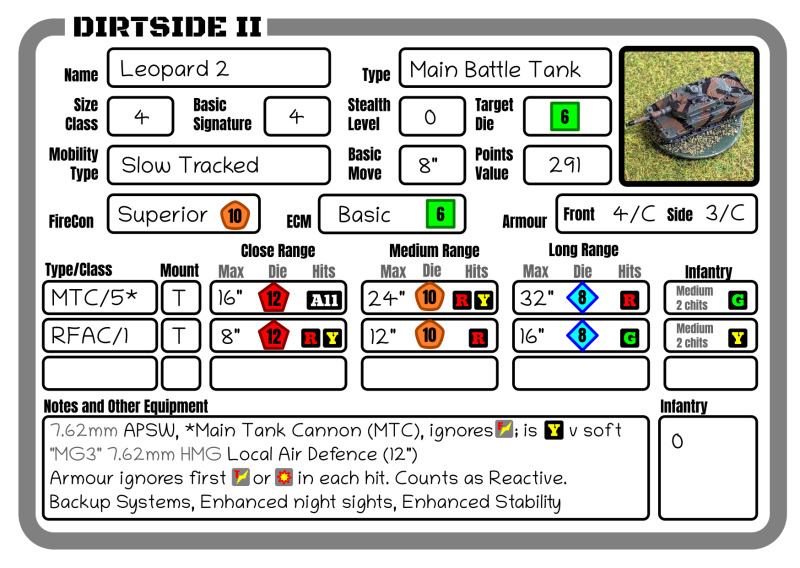
I have invented two new weapon types for the these tanks – the rifled tank gun for the Challenger and the Smoothbore tank gun for the Leopard (the Abrams will use the same). They are precursors to the HVC which is the ‘early’ main tank gun in the Dirtside main rules.
So I might do a bit of tweaking, but the plan for next time is to try a more infantry focused game.
This game went okay though. I do like that the modern tanks are hard to actually kill, but do suffer mobility hits and take damage. I could also do with some more varied terrain types – urban models would be very useful, as well as roads and rivers. I have very little of this that is suitable for 6mm, so one of my aims this year is possibly buy some.
Interesting. Does Dirtside have any way of simulating drone strikes and/or drone-guided artillery? Those approaches have served to make actual tank battles relatively rare in the current conflict.